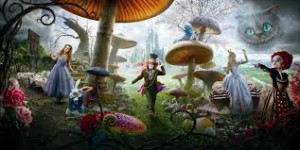The Magnificent (and Slightly Mad) Mind of Tim Burton
Film directors each have a unique and distinct visual style in their movies, but the director who has the most whimsical—and slightly creepy—design style is Tim Burton. With their dark scenery, fanciful effects, fantastical storylines, and eccentric characters, even the most film-illiterate human beings could immediately recognize one of Burton’s widely popular movies.
From live action films, such as Alice in Wonderland and Sleepy Hollow, to animations, like the Corpse Bride and the Nightmare Before Christmas, the twisted humor and cartoonish horrors of Burton’s imagination seem to be the sick fantasies of a deranged lunatic.
But sometimes the craziest people are the most ingenious.
“The line between drawing and film, pencils and pixels, according to Rumsey, is a mere wisp to Tim Burton, as he plucks all these original ideas out of the shadowy abyss of his own mind.”
Even though these films are each wildly imaginative, Mr. Darkness and Outlandishness himself has a consistent visual style—a method to his madness, if you will—that he uses to guide the look and feel of his movies.
In Auteur’s Theory of Tim Burton, blogger Manda Hanz details Burton’s unfailing use of odd camera angles, such as the “eye-level shot, close up, medium shot, wide-angle shot, and aerial shot.” She explains that these bizarre camera practices are used in Burton’s films in order to emphasize the individual characters, as well as the imaginative world around them.
Lighting, according to Hanz, is another crucial element that Burton likes to manipulate and, ironically, create the perfect amount of darkness and contrast. In his films, Burton tends to build worlds that are essentially dreamscapes or portals into people’s minds.
To achieve these surrealistic realities, Hanz’s post mentions that Burton makes use of “background lighting” to “separate an object from the background” and “key lighting” in order to “highlight a specific form.” These lighting styles can be seen in a majority of his films, but especially in animated sequences with backdrops, such as the Nightmare Before Christmas and Frankenweenie.
Lighting also helps Burton to create a distinctive color scheme, which both oversaturates and under-saturates the vibrancy of the colors to match the mood of a scene or the overall personality of a character.
In a more quick and succinct analysis of Burton’s style, Meredith Woerner’s io9 lists the ten most noticeable, telltale signs of the director’s style. Among the many trademarks listed, the most recognizable are the “blond innocents, scary monsters, rebellious women, and skittish outcasts” that populate Burton’s fictional universes.
Woerner describes Burton’s fascination with estranged and aloof characters that are “trapped in their own worlds,” explaining that the eclectic mix of character dispositions create harmony not only in Burton’s films but also in his own mind. In his movies, people are innocent, ostracized, unconventional, frightening, and malicious in order to invent a story that is three-dimensional and relatable to a universal audience.
Straight from the mind of the madman himself, Open Culture’s Adrienne Rumsey provides a video of Tim Burton “discussing the cultivation of his signature style” and “unique imagery.” Burton explains that he has been illustrating since he was a young child, as he was encouraged by one of his teachers to invent his own drawing style. For Burton, visually expressing “his fantasy life and emotional core” is the focus of his film methodology.
By drawing out his ideas and essentially spilling the contents of his brain onto paper, Burton is able to conceptualize these peculiar characters and concoct foreign lands. The line between drawing and film, pencils and pixels, according to Rumsey, is a mere wisp to Tim Burton, as he plucks all these original ideas out of the shadowy abyss of his own mind.
His obsession with the macabre and the loneliness of a person’s inner thoughts is the chemical formula of his success as both a director and artist. That, and apparently striped socks are the key to unlocking the hidden secrets of Tim Burton’s mind.
“One person’s craziness is another person’s reality.”
-Tim Burton
Watching a Tim Burton film is like taking a trip into the deep unknown, a hidden world of wonders, terrors, and art. Tim Burton films can only be defined as a dark light, a description that is as uncanny and nonsensical as the director’s work.
Even as he became more successful in his career, Tim Burton managed to stick to his twisted roots and maintain his style in the majority of his films. With both his illustrations and filmography, Burton continues to create these strange and unusual masterpieces that manage to tickle the darkness that no doubt lies in every soul.
Watch Tim Burton walk about his career.







